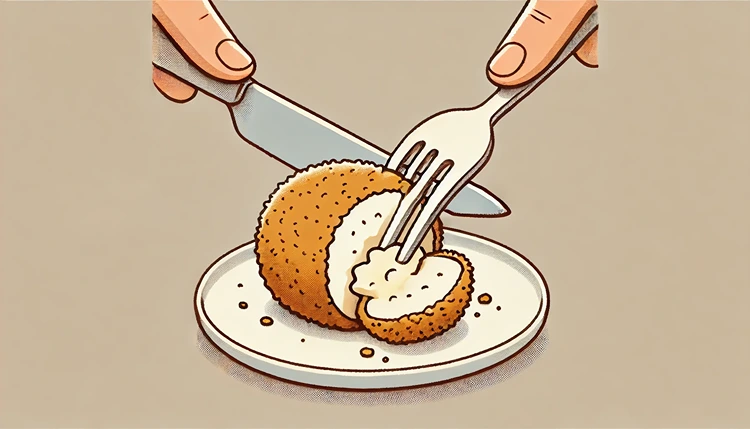It’s easy to get confused between Spanish croquetas and French croquettes. At first glance, these two seem almost identical—both fried, crispy, and filled with delicious ingredients. But beneath the surface, there are some important distinctions between these iconic dishes. While they may share similarities, their differences come down to key aspects like the ingredients, preparation methods, and cultural significance. If you’ve ever wondered what sets these two apart, you’re not alone.
Let’s break down everything you need to know about croquetas and croquettes, so the next time you’re enjoying either, you can appreciate the differences!
What are Spanish Croquetas?
Croquetas are a beloved part of Spanish cuisine, often served as tapas in bars across the country. These little bites are typically made with a creamy béchamel sauce, combined with various ingredients, and then fried to golden perfection.
- **Béchamel base**: The defining feature of croquetas is the béchamel sauce, which gives them a smooth, creamy interior.
- **Fillings**: Common fillings include ham (jamón), chicken, cod, or mushrooms. These ingredients are finely chopped or shredded and mixed into the béchamel for a rich and flavorful bite.
- **Crispy coating**: Croquetas are rolled in breadcrumbs and fried, resulting in a crunchy exterior that contrasts beautifully with the creamy filling.
Helpful Hint:
When making croquetas at home, be sure to refrigerate the béchamel mixture for a few hours before forming the croquettes. This helps the mixture firm up and makes it easier to shape without falling apart during frying.
What are French Croquettes?
French croquettes, on the other hand, have their own unique twist. While they share a similar shape and fried exterior with their Spanish counterpart, the filling and texture set them apart.
- **Potato-based**: Unlike croquetas, which are made with béchamel, French croquettes usually have a mashed potato base, giving them a denser texture.
- **Meaty fillings**: French croquettes are often filled with minced meat, chicken, or fish. The mixture is richer and more substantial compared to the creamy béchamel used in Spanish croquetas.
- **Breadcrumb coating**: Like croquetas, croquettes are breaded and fried, but the firmer texture of the potato-based filling holds up better to the crispy exterior.
How Are They Made? Key Preparation Differences
The biggest difference between Spanish croquetas and French croquettes comes down to how they’re prepared. While both require similar techniques—rolling, breading, and frying—the steps involved and ingredients used differ significantly.
Spanish Croquetas Preparation
Making croquetas involves creating a béchamel sauce from butter, flour, and milk. Once thickened, this sauce is mixed with the chosen fillings (like ham or chicken). The mixture is cooled until firm enough to shape into balls or logs. After shaping, they are coated in breadcrumbs and fried until golden brown.
French Croquettes Preparation
French croquettes, by contrast, begin with mashed potatoes mixed with meats or vegetables. The mixture is seasoned, sometimes incorporating herbs or spices. The croquettes are then shaped, breaded, and fried, just like their Spanish cousins, but the final result has a firmer, starchier texture due to the potato base.
Texture: Creamy vs. Starchy
When biting into a Spanish croqueta, you’re greeted with a creamy, almost velvety interior. The béchamel base melts in your mouth, providing a smooth and luxurious texture. The fillings are usually finely minced or shredded, so the flavor is well-distributed throughout the croqueta.
By comparison, a French croquette has a denser, starchier texture thanks to the potato base. The interior is more solid, and you’ll often find larger chunks of meat or vegetables inside, giving each bite a more substantial mouthfeel.
Popular Variations: From Ham to Cod
Both croquetas and croquettes offer a variety of flavors depending on the region or the chef’s creativity. Let’s explore some of the most common variations of each dish.
Spanish Croquetas Variations
Croquetas de Jamón: Perhaps the most iconic variety, these are made with finely chopped jamón ibérico (Spanish ham). The rich flavor of the ham pairs perfectly with the creamy béchamel.
Croquetas de Bacalao: A classic option, these croquetas are filled with salt cod. This variation is especially popular in coastal regions of Spain.
Croquetas de Pollo: Chicken croquetas are another common choice, with the shredded chicken adding a delicate flavor to the béchamel.
French Croquettes Variations
Croquettes de Pommes de Terre: These potato-based croquettes are filled with meat or fish, often seasoned with herbs like parsley or thyme.
Croquettes de Poulet: Filled with minced chicken, these croquettes are a popular choice in France, especially as a starter or side dish.
Croquettes de Fromage: Cheese lovers can enjoy these croquettes made with melted cheese, offering a gooey interior encased in a crispy shell.
Helpful Hint:
If you prefer a more adventurous filling, try adding spices like nutmeg or smoked paprika to your croquettes. This adds depth to the flavor without overpowering the other ingredients.
Key Differences Between Croquetas and Croquettes
| Aspect | Spanish Croquetas | French Croquettes |
|---|---|---|
| Main Ingredient Base | Béchamel sauce | Mashed potatoes |
| Typical Fillings | Ham, chicken, cod, mushrooms | Meat, fish, cheese |
| Texture | Creamy and smooth | Firm and starchy |
| Common Serving Style | Tapas, casual dining | Appetizer or side dish |
| Cultural Significance | Staple of Spanish tapas culture | Elegant, often served in bistros |
| Popular Variations | Croquetas de Jamón, Croquetas de Bacalao | Cheese croquettes, Croquettes de Poulet |
| Calories (approximate per serving) | 200-300 calories | 250-350 calories |
Cultural Significance: How Croquetas and Croquettes Reflect Their Roots
Croquetas and croquettes aren’t just tasty snacks—they also hold a deep cultural significance in their respective countries. Understanding their role in Spanish and French cuisine gives us a glimpse into the heart of each culture’s relationship with food.
Spanish Croquetas: A Tapas Tradition
In Spain, croquetas are a staple of the tapas tradition, small dishes shared among friends and family. This casual, communal style of eating is a defining feature of Spanish dining culture, and croquetas fit right in. They’re the perfect bite-sized food to enjoy with a glass of wine or beer, whether you’re at a bustling bar in Madrid or a coastal eatery in Barcelona.
Croquetas are so beloved in Spain that they’ve become an essential dish for many households, especially during holidays or special gatherings. Families often pass down their own croqueta recipes, which adds to the dish’s sentimental value.
French Croquettes: A Classic Side Dish
In France, croquettes often serve as a side dish or appetizer, typically accompanying a more elaborate main course. French cuisine is known for its emphasis on technique and presentation, and croquettes reflect this with their crisp, uniform exterior and delicate balance of flavors. They’re frequently found on the menus of bistros and brasseries, where they complement dishes like steak frites or roasted poultry.
While not as commonly eaten as an everyday snack like their Spanish counterpart, French croquettes have a place in more formal dining settings, where they showcase the elegance and precision that defines French cooking.
Serving Styles: Bar Snack or Formal Dish?
One of the most notable differences between Spanish croquetas and French croquettes is how they’re served. While both dishes are versatile enough to be enjoyed in different settings, their typical presentation varies depending on the country.
How Spanish Croquetas Are Served
In Spain, croquetas are almost always served as part of a tapas spread. This means you’ll typically get a small plate of croquetas alongside other favorites like patatas bravas, gambas al ajillo (garlic shrimp), and tortilla española (Spanish omelette). The focus is on sharing, and croquetas are designed to be eaten in a relaxed, communal atmosphere.
Many tapas bars will offer a variety of croquetas, so you can mix and match flavors—ham, chicken, mushroom, or cod—all in one sitting. They’re often eaten with your hands, further adding to the casual nature of this dish.
How French Croquettes Are Served
In contrast, French croquettes are more commonly found as a plated side dish, served alongside a larger meal. While you might see them as a starter at a fancy restaurant, they’re often placed next to a piece of meat or fish on the plate, functioning as a complement rather than the star of the show. The emphasis is more on balance and refinement, with croquettes playing a supporting role to the main course.
That said, croquettes can also be served as canapés at more formal events, where their bite-sized elegance fits in well with the sophisticated setting. Whether served in a restaurant or at a gathering, French croquettes are typically eaten with a fork and knife, highlighting the more refined dining culture of France.
Health Considerations: Which Is Healthier?
When it comes to health, both croquetas and croquettes are indulgent foods, thanks to their fried exterior and rich fillings. But there are some differences in their nutritional profiles based on the ingredients used.
Spanish Croquetas: Rich and Creamy
Since croquetas are made with a béchamel sauce, they tend to be higher in fat due to the butter, flour, and milk that form the base of the sauce. The fillings, especially ham or cheese, can also contribute to a higher fat and calorie content. However, croquetas are usually eaten in small portions, so while they’re indulgent, they’re often enjoyed in moderation as part of a tapas meal.
French Croquettes: Starchy and Filling
Croquettes, on the other hand, are potato-based, which means they’re higher in carbohydrates. Depending on the filling—whether meat, cheese, or vegetables—their calorie and fat content can vary. However, since potatoes are the primary ingredient, croquettes are more filling and can offer a more substantial meal when compared to the lighter béchamel-based croquetas.
Stats:
On average, a serving of Spanish croquetas contains around 200-300 calories, while French croquettes can range from 250-350 calories per serving, depending on the filling.
Can You Make Them at Home? Tips for Perfect Croquetas and Croquettes
Both croquetas and croquettes are relatively simple to make at home, but they do require a bit of patience and technique to get them just right. Let’s look at some tips to ensure your homemade versions are as tasty as the ones you’d find in Spain or France.
Tips for Making Spanish Croquetas
Nail the béchamel: The key to a good croqueta is a smooth, thick béchamel sauce. Make sure to cook the flour and butter mixture long enough before adding the milk to avoid any raw flour taste.
Chill the mixture: After mixing in your fillings, refrigerate the béchamel mixture for at least 2-3 hours (or even overnight). This will make it much easier to shape the croquetas.
Fry in hot oil: For the crispiest exterior, make sure your oil is hot before frying (around 350°F/175°C). Fry in small batches to avoid overcrowding the pan.
Tips for Making French Croquettes
Use starchy potatoes: For the best texture, use starchy potatoes like Russets when making croquettes. They’ll give you a fluffier filling that holds together well.
Don’t overmix: When combining the mashed potatoes with the other ingredients, be careful not to overmix. Overmixing can make the potatoes gummy and dense.
Double breading for extra crunch: For an even crispier croquette, try double breading. Dip the croquettes in egg and breadcrumbs twice before frying.
Helpful Hint:
To prevent your croquettes from bursting open while frying, be sure to seal any cracks in the breading before dropping them into the oil. A double breading can also help keep everything intact.
Popularity: Croquetas vs. Croquettes Around the World
While Spanish croquetas and French croquettes originate from two different countries, both have gained popularity far beyond their borders. Let’s explore how each has made its mark on international cuisine and why these fried delights are beloved by so many.
Spanish Croquetas: A Global Tapas Favorite
The popularity of Spanish croquetas has skyrocketed over the years, thanks in large part to the rise of tapas bars around the world. You can now find croquetas served in cities like New York, London, and Tokyo, where Spanish cuisine has become a trendy dining experience. These tasty bites are often the first thing people order when they sit down for tapas, and it’s easy to see why.
The adaptability of croquetas also plays a big role in their popularity. From ham and cheese to more adventurous fillings like chorizo or seafood, there’s a croqueta flavor for everyone. This versatility has helped Spanish croquetas win the hearts of food lovers everywhere.
French Croquettes: An Elegant Addition to International Menus
While French croquettes may not have the same global recognition as Spanish croquetas, they’ve found their place in more refined dining settings. French restaurants and bistros around the world often include croquettes as a side dish or appetizer, pairing them with classic French dishes like coq au vin or bouillabaisse.
In places like Paris and Montreal, croquettes are a staple on many menus, showcasing the sophisticated flavors and textures that French cuisine is known for. The appeal of croquettes lies in their simplicity—whether filled with mushrooms, poultry, or even truffles, they add an extra layer of elegance to any meal.
Modern Twists on Classic Recipes
As both croquetas and croquettes have spread across the globe, chefs have gotten creative with their recipes, offering exciting new takes on these traditional dishes. Let’s look at some of the modern variations you might find in restaurants today.
Fusion Croquetas
In recent years, fusion cuisine has breathed new life into the traditional Spanish croqueta. Some chefs have started incorporating global flavors, such as Asian spices or Mexican ingredients, into their croqueta fillings. Imagine a croqueta filled with pulled pork and chipotle, or one flavored with curry spices—these innovations add an exciting twist to a well-loved classic.
Even vegan and vegetarian options are becoming more common, with croquetas filled with plant-based ingredients like mushrooms, spinach, or plant-based meats. This makes croquetas even more accessible to people with different dietary preferences, helping them maintain their popularity in the modern culinary scene.
Gourmet Croquettes
On the French side, gourmet croquettes have become a trend in upscale dining establishments. Chefs are incorporating luxury ingredients like lobster, foie gras, or black truffle into their croquette recipes, elevating this simple dish to new heights. These gourmet croquettes are often served as part of a tasting menu, where the focus is on high-end ingredients and refined preparation techniques.
The use of different breadcrumbs—like panko or herb-infused coatings—has also given French croquettes a modern makeover. These variations not only enhance the texture but also provide a unique flavor profile that complements the filling inside.
Where to Find the Best Croquetas and Croquettes Around the World
If you’re looking to try some of the best croquetas or croquettes the world has to offer, there are a few places you definitely need to visit. These regions and cities are known for serving up top-quality versions of these iconic dishes.
Best Places to Eat Croquetas in Spain
Madrid: The capital city of Spain is home to some of the best tapas bars in the world. Head to Casa Lucio or Bodega de la Ardosa for traditional croquetas that will make you fall in love with Spanish cuisine all over again.
Barcelona: Known for its vibrant food scene, Barcelona offers an incredible variety of croquetas. Try Quimet & Quimet for a modern take on this classic dish, or visit El Xampanyet for a more traditional version.
Seville: Down south in Seville, you’ll find croquetas with local flavors, like croquetas de espinacas con garbanzos (spinach and chickpeas) or croquetas de jamón. For an authentic experience, stop by Bar Las Teresas or Casa Morales.
Best Places to Eat Croquettes in France
Paris: In the heart of France, you’ll find croquettes at many elegant bistros and restaurants. Try Le Comptoir for croquettes made with seasonal ingredients or L’Ami Jean for a more rustic take on the dish.
Lyon: Known as the gastronomic capital of France, Lyon offers plenty of options for croquette lovers. Head to La Mère Brazier for a Michelin-starred meal that includes gourmet croquettes as part of a larger tasting menu.
Marseille: Down by the Mediterranean, you’ll find croquettes with a touch of seafood flair. Restaurants like Chez Fonfon and Le Petit Nice offer croquettes that reflect the fresh ingredients of the region.
Stats:
According to a 2022 survey by the Spanish Ministry of Agriculture, croquetas are one of the top three most consumed tapas dishes in Spain, with over 60% of people reporting they order them regularly when dining out.
FAQs
Wrapping Up
Spanish croquetas and French croquettes may look similar, but their differences in ingredients, texture, and cultural roots make each unique. Croquetas are beloved for their creamy béchamel filling and deep connection to Spain’s tapas culture, while croquettes stand out with their potato-based heartiness and refined place in French dining. Whether you’re enjoying a casual tapas meal or an elegant French appetizer, understanding these key differences will elevate your appreciation for both dishes. If you’re up for a culinary adventure, try making them at home with the tips shared in this article.
These two iconic bites represent the richness of both Spanish and French cuisine. So, next time you find yourself in a Spanish tapas bar or a French bistro, you’ll know exactly what to order and why. Stay curious and continue exploring the delicious world of croquetas and croquettes—you won’t be disappointed!







